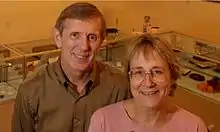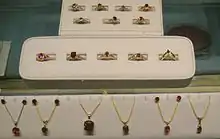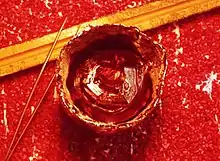Shelby Gem Factory
The Shelby Gem Factory, also known as ICT Incorporated, was a Michigan company that manufactured artificial gemstones through proprietary processes. The factory made more varieties of man-made gemstones than any other in the world.[1][2] [3][4][lower-alpha 1] It grew artificial gems and gem simulants, including synthetic ruby and sapphire and simulated diamonds,[2][7] citrine, topaz, and other birthstone substitutes, and mounted them in gold or silver jewelry.

History

ICT Incorporated, trade name "Shelby Gem Factory", is sited in Shelby, Oceana County, on the west coast of the Lower Peninsula of Michigan.[2][8] It was founded in 1970 by Larry Paul Kelley.[2][7] and Craig Hardy.[9] Larry Paul Kelley and his wife Jo Kelly later retained full ownership making the Shelby Gem Factory a family business.[10][2][11][12]
The Shelby Gem Factory initially produced only synthetic ruby, with ruby lasers being the principal application, to firms primarily in California.[9] However, the greater profit potential of transmuting ruby rods into gemstones led to a change in the enterprise's focus.[9] A colorless variant crystal was developed by experimentation with different materials and proportions.[9] This was the first simulated diamond variety.[4] It became the first business anywhere to mass-produce cubic zirconia (CZ). In the 1970s the Shelby Gem Factory rode a wave of popularity CZ then enjoyed. At its peak, tons of cubic zirconia were produced for the world market. Subsidiary factories were opened in China, India, and Panama to keep up with demand.[7]
The factory closed in 2019, after 50 years of manufacturing.[13]
Factory

Formerly, factory tours were offered.[14][15][16] However, they were discontinued – due to liability concerns attendant to the "very high temperatures and extremely bright light" and the unavailability of affordable insurance to cover the risk.[4] Some of the furnaces burn at 5,040 °F (2,780 °C).[14]
The factory features a museum, a showroom, and a theater and is a popular destination for schools, venture tours, and lapidary clubs. The 50-seat Art and Science theater shows visitors the differences between the processes that produce natural and man-made gems.[3] Exhibits on-site include a lapidary machine visitors can try out for themselves to learn about gem cutting and a low-temperature model of a working crucible-furnace, along with photos of the now-off-limits factory floor.[4]
The public can purchase gemstone jewelry from the factory.[9] Jo Kelley, wife of Larry Paul Kelley, attributes the factory's increase in sales between 2008 and 2010 to the weak national economy.[17] [18][19]
Gem manufacturing



The gems are synthesized in a furnace. It uses a US $85,000 heat resistant iridium[4] crucible heated by surrounding electric coils. Temperatures range from 3,500 to 5,000 °F (1,930 to 2,760 °C). A crystal-producing mix is put into this furnace and melted. Then a slowly-spinning rod, the "seed", is lowered into the crucible, circulating the molten minerals, creating a homogeneous mixture and maintaining an even temperature throughout. Raised slowly over the course of weeks, the rotating rod cools the liquid and allows a large crystal to form. Kelley says it takes several weeks to grow a gem crystal.[17]
The factory does not use the Verneuil method of "pulling" crystals, using temperature differences like the process that forms an icicle. Rather, it uses small fragments of mined gems, which are then used as seeds to re-crystallize liquid into larger gemstones. This is the so-called Czochralski process, which is akin to chemical vapor deposition. According to Kelly: "As far as I know, we are the only company on Earth that uses the second method."[4]
Shelby Gem Factory workers then cut several dozen rough gems from each crystal using a diamond saw. A rough gemstone piece is placed onto a faceting machine, where over fifty facets are cut and polished to create a finished gemstone.[17] ICT has a master jeweler on staff to mount the finished gemstones in gold settings; Kelley purchases rough gold castings from out of state, and finishes these at the factory to make settings as needed.[17] The crystals made by the Shelby Gem Factory are used in jewelry and scientific industries worldwide. Unlike naturally-produced stones, these products are free of occlusions and internal and external flaws or inclusions.[20]
The Shelby Gem Factory's simulated diamonds are diamond simulants, which are not to be confused with actual lab-grown synthetic diamonds. However, they can be difficult to distinguish from real diamonds.[9] They have a D color rating, the highest rating for diamonds (as determined by the Gemological Institute of America).[lower-alpha 2]
Although some of the company's products are "simulants" (such as their diamond simulants), their synthetic ruby and sapphire stones are not imitations – they have the same chemical and crystalline structure that is found in natural stones. The factory's FAQ says "our rubies and sapphires are really ruby and sapphire!"[21]
The Shelby Gem Factory also manufactures simulated citrine and topaz, along with other birthstone substitutes.[4]
As per the company website's FAQ section in 2017,[21] below are the Mohs scale hardness values for some well-known gems along with Shelby gem products:
- Genuine diamond, 10
- Ruby, sapphire, Shelby ruby, and Shelby sapphire, 9
- Shelby simulated diamond ("Diamond Encore"), 8-7/8
- Shelby simulated emerald, aquamarine, and garnet, 8.6
- Genuine emerald and aquamarine, 7.5-8.0
- Genuine garnet, 6.0
The company's policy is to maintain the confidentiality of celebrity clients, of whom there are many.[1]
See also
Notes
- The company website says "We...are the only company in the world that...makes uncut gems, facets them, [and] mounts them in gold..."[5][6]
- Kelley also makes the claim that it is impossible to distinguish a Shelby simulated diamond from a natural one using only the naked eye. See Crystallographic defects in diamond.[2]
References
- Burcar, Colleen (October 2, 2012). Michigan Curiosities: Quirky Characters, Roadside Oddities & Other Offbeat Stuff (3rd ed.). Lanham: Rowman & Littlefield, Globe Pequot Press. p. 153. ISBN 9780762790678.
- Zoladz, Chris (February 14, 2013). "Made in Michigan: The Shelby Gem Factory". Lakeshore News Top Headlines. WZZM television station. Retrieved September 3, 2015.
The company makes a wider variety of gem stones than any other company in the world.
-
"Shelby Man-Made Gemstone Factory". Pure Michigan. Michigan Economic Development Corporation. 2015. Retrieved September 3, 2015.
The factory...in operation since 1970...makes more varieties of Man-Made Gemstones than any other company in the World.
- Kates, Kristi (December 31, 2012). "A Flaming Success at the Shelby Gem Factory". Northern Express. Retrieved September 8, 2015.
- "Shelby Gem Factory Home page". Shelby Gem Factory. Retrieved November 6, 2015.
- "West Michigan Works: A visit with Shelby Gem Factory" (Video). Mason County Press. June 19, 2015. Retrieved December 10, 2017.
- "Shelby Gem Factory celebrates 40 years". Oceana's Herald-Journal. December 1, 2010. Retrieved September 3, 2015.
- Albrecht, Julie (March 31, 2007). Traveling Michigan's Sunset Coast (Paperback). Dog Ear Publishing. p. 144. ISBN 9781598583212.
- Rohan, Harry (September 18, 1992). "Success Glitters / Firm shines at producing gem substitutes". Detroit Free Press. Detroit, Michigan. p. 55.
- Keefer, Melissa (February 7, 2015). "Shelby Gem owners love using science to create beauty". Ludington Daily News.
- Pohlen, Jerome (May 1, 2014). Oddball Michigan: A Guide to 450 Really Strange Places (Paperback). Chicago, Illinois: Chicago Review Press. pp. 137–138. ISBN 9781613748961.
- "A Flaming Success at the Shelby Gem Factory". Northern Express. December 30, 2012. Retrieved December 11, 2017.
- "Shelby Gem Factory to close". Oceana County Press. December 13, 2019. Retrieved March 8, 2020.
- DeZutter, Hank; DeZutter, Pamela Little (June 3, 1993). "Idlewild, Michigan: These Parts". Chicago Reader. Retrieved November 8, 2015.
- Bonstell, Christy L. (August 2, 2008). "Factory tours take you behind the scenes and satisfy your curiousity [sic]". The Detroit News. Retrieved October 4, 2017.
- "Michigan Living, AAA Michigan". 75. Automobile Club of Michigan. 1993: 20. Cite journal requires
|journal=(help) - Tableman, Jan (2011). "Jewel of West Michigan: Shelby Gem Factory". Michigan Country Lines. Okemos, Michigan: Michigan Electric Cooperative Association: 1, 3, 10–11.
- Burcar, Colleen; Taylor, Gene (2003). Michigan: Quirky Characters, Roadside Oddities and Other Offbeat Stuff (Paperback). Globe Pequot Press. p. 157. ISBN 9780762706013.
- "Jewelers' Circular/keystone '77 Directory". 150 (1–5). Chilton Company. 1979: 92. Cite journal requires
|journal=(help) - Heim, Michael (January 1, 2004). Exploring America's Highways: Michigan Trip Trivia (Paperback). Wabasha, Minnesota: Travel Organization Network Exchange (T.O.N.E. Publications). p. 170. ISBN 9780974435824.
- "FAQs". Shelby Gem Factory. Retrieved October 5, 2017.
External links
| Wikimedia Commons has media related to Shelby Gem Factory. |